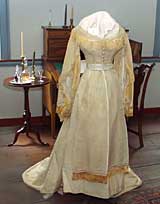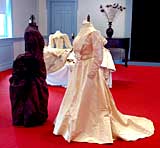EXPERIENCING 150 YEARS OF WEDDING DRESSES
Historical Exhibit Spotlights Uniquely Female Art Form

By Hoag Levins ...| ...June 8, 2003

Also See More coverage from same event:
> Gown Exhibit 1 |
Gown Exhibit 2 |
Tea and Treats |
Main Story
CAMDEN, N.J. -- For a Quaker woman of the 1860s, the wedding dress certainly seemed more than a little daring.

|
| Photo: Hoag Levins |
Displayed in the parlor of Pomona Hall, an 1868 Quaker wedding gown has a surprisingly sensual cut. Also see larger photo.
|
The elegant silk gown with satin-lined kimono sleeves and a plunging neckline surely turned many an eye when it was worn at a Camden ceremony in 1868. Opulently trimmed in braid and lush fringe, the garment was one of the most talked about displays at the Camden County Historical Society's antique wedding exhibit that ran from May 28 to June 4.
The unexpected
"It does seem at odds with our general sense of the Quaker tradition for simplicity and unpretentious dress," said Judith Snyder, director of the Historical Society's museum. "But documenting the unexpected is part of what makes the study and display of historic artifacts so interesting."
Another unexpected item was a wedding gown from the 1880s that was the color of dark chocolate -- it is thought to be a combination wedding-and-mourning dress worn by a widow who remarried within a year of her first husband's death, according to Ms. Snyder.
Three-part event
The wedding garment exhibit was one element of a three-part event that took place on May 28 and included an afternoon tea in Pomona Hall, the restored 18th-century mansion maintained

|
| Photo: Hoag Levins |
The deep chocolate brown garment on the left is believed to be a combination mourning-and-wedding dress. Also see larger photo.
| by the Historical Society, as well as a one-hour presentation by Jane Peters Estes, a historian who spoke on the origins of wedding customs.
"This is the kind of museum experience that makes history real -- you can actually see it happening," said Historical Society president Richard Pillatt. "It's one thing to hear about whalebone corsets and another to stand up close to a dress with a corseted 16-inch waist. The design history on display here is amazing. We've had women walking around the bustled dress learning that the purpose of the huge bustle was to further exaggerate the thinness of the waist. You could see them walking behind the bustle and actually seeing that effect for the first time. This is living history at its best, and we are looking forward to doing this wedding theme again."
150 years
The exhibit of wedding garments from the Society's extensive textile collection covered 150 years of marriage history from 1840 to 1991. Seven gowns representing the decades of the 1940s to the 1990s were loaned to the exhibit by members of the Mary Cooper Gardeners, the volunteer historical services group that organized the show with Ms. Snyder. It was the first time most of the garments from the collection had been displayed in

|
| Photo: Hoag Levins |
Historian Jane Peters Estes spoke on the origins of wedding customs. Also see larger photo.
|
the 103-year history of the Historical Society.
"The original plan was for the whole thing to be a one-day event on May 28th," explained Ms. Snyder. "But the women who came that day went back and told their friends; visitors continued to come for days. Several of us came in over the weekend to begin taking down part of the display; but when we arrived there was a group of women waiting at the front door because they wanted to see the dresses. So, we let them in and decided to leave it all up for several more days."
Unique female art form
"The popularity of the thing didn't surprise me, but I know it does mystify some men," said Ms. Snyder. "As a genre, wedding dresses are a unique female art form that plays a central role in one of our society's most important social rituals. Few garments -- except perhaps military uniforms -- are imbued with the same kind of potent symbolism as wedding gowns," she said.
"They are rich historical documents that tell us about their era's technology, textile materials and craftsmanship. They tell us about economics and local community status. They also tell us about the romantic fantasies of the generations of Camden

|
| Photo: Hoag Levins |
The tea portion of the event featured a dining room table with a centerpiece wedding cake surrounded by an assortment of treats made by Society volunteers. Also see larger photo.
|
County women who created and wore them. Each garment was envisioned and created for an individual woman's 'princess' day. That's what weddings are -- the day on which the bride gets to present herself as a princess to the world. And she also gets to design her ultimate princess dress. Basically, in putting this show together, the Mary Cooper Gardeners wanted it to be a gallery experience that allowed visitors to walk through a 150-year history of wedding fantasies executed in silk and satin and lace."
'Struck a chord'
Sandy Levins, who is director of the Mary Cooper Gardeners and the Historical Society's director of programming, said, "We wanted some of the Society's extensive but little-known textile collection to see the light of day and we wanted to reach out to a broad audience of women across the entire county -- this wedding tea and exhibit idea appears to have struck a chord."
The Mary Cooper Gardeners -- they take their name from the 1788 mistress of Pomona Hall -- held their first historic tea in the mansion last year. That led to this year's expanded concept of an afternoon tea, exhibit and presentation coordinated around a wedding theme.
| 


